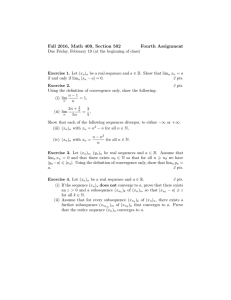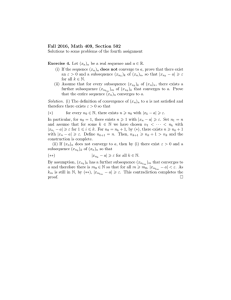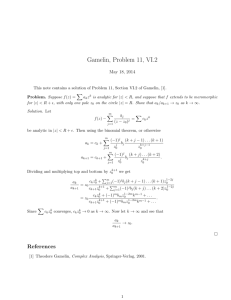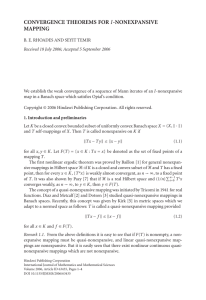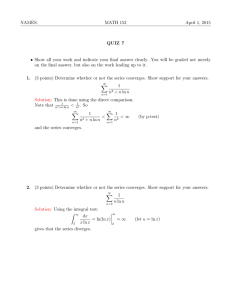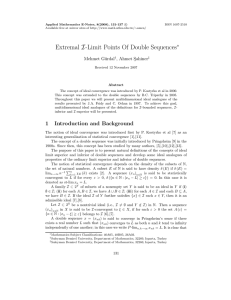61 (2009), 103–110 IMPLICIT APPROXIMATION METHODS FOR COMMON FIXED
advertisement
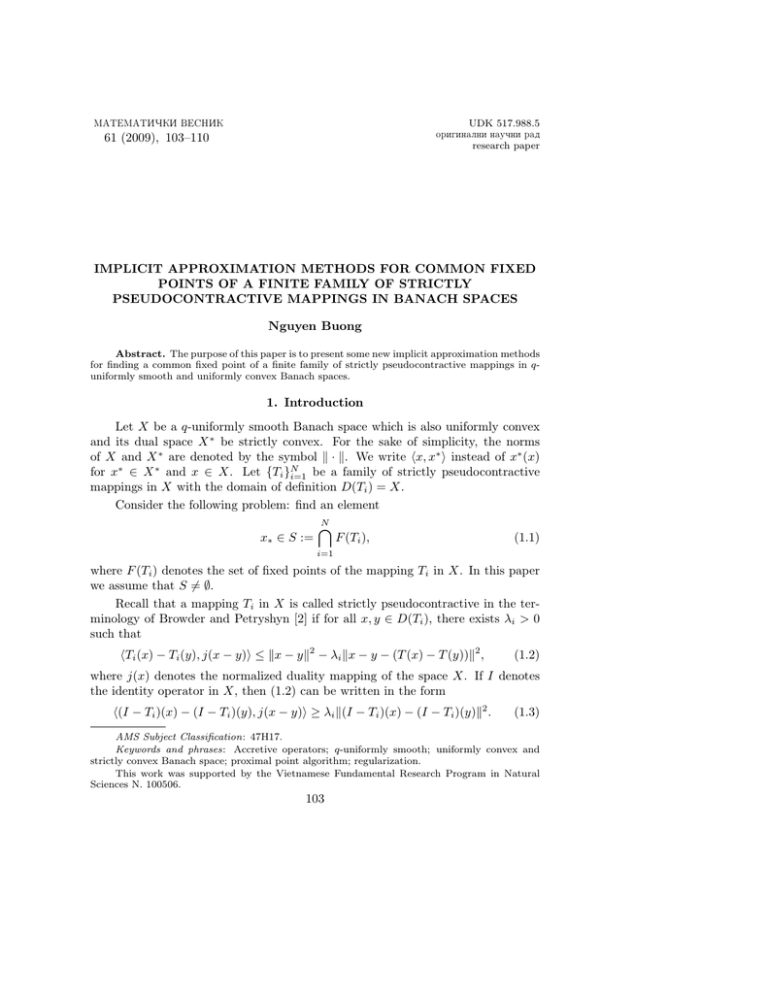
MATEMATIQKI VESNIK
UDK 517.988.5
originalni nauqni rad
research paper
61 (2009), 103–110
IMPLICIT APPROXIMATION METHODS FOR COMMON FIXED
POINTS OF A FINITE FAMILY OF STRICTLY
PSEUDOCONTRACTIVE MAPPINGS IN BANACH SPACES
Nguyen Buong
Abstract. The purpose of this paper is to present some new implicit approximation methods
for finding a common fixed point of a finite family of strictly pseudocontractive mappings in quniformly smooth and uniformly convex Banach spaces.
1. Introduction
Let X be a q-uniformly smooth Banach space which is also uniformly convex
and its dual space X ∗ be strictly convex. For the sake of simplicity, the norms
of X and X ∗ are denoted by the symbol k · k. We write hx, x∗ i instead of x∗ (x)
for x∗ ∈ X ∗ and x ∈ X. Let {Ti }N
i=1 be a family of strictly pseudocontractive
mappings in X with the domain of definition D(Ti ) = X.
Consider the following problem: find an element
x∗ ∈ S :=
N
\
F (Ti ),
(1.1)
i=1
where F (Ti ) denotes the set of fixed points of the mapping Ti in X. In this paper
we assume that S 6= ∅.
Recall that a mapping Ti in X is called strictly pseudocontractive in the terminology of Browder and Petryshyn [2] if for all x, y ∈ D(Ti ), there exists λi > 0
such that
hTi (x) − Ti (y), j(x − y)i ≤ kx − yk2 − λi kx − y − (T (x) − T (y))k2 ,
(1.2)
where j(x) denotes the normalized duality mapping of the space X. If I denotes
the identity operator in X, then (1.2) can be written in the form
h(I − Ti )(x) − (I − Ti )(y), j(x − y)i ≥ λi k(I − Ti )(x) − (I − Ti )(y)k2 .
(1.3)
AMS Subject Classification: 47H17.
Keywords and phrases: Accretive operators; q-uniformly smooth; uniformly convex and
strictly convex Banach space; proximal point algorithm; regularization.
This work was supported by the Vietnamese Fundamental Research Program in Natural
Sciences N. 100506.
103
104
Nguyen Buong
In the Hilbert space H, (1.2) (and hence (1.3)) is equivalent to the inequality
kTi (x) − Ti (y)k2 ≤ kx − yk2 + ki k(I − Ti )(x) − (I − Ti )(y)k2 ,
k i = 1 − λi .
Clearly, when ki = 0, Ti is nonexpansive, i.e.,
kTi (x) − Ti (y)k ≤ kx − yk.
Wang [11] proved the following result.
Theorem 1.1. Let H be a Hilbert space, T : H → H a nonexpansive mapping with F (T ) 6= ∅, and F : H → H an η-strongly monotone and k-Lipschitzian
mapping. For any x0 ∈ H, {xn } is defined by
xn+1 = αn xn + (1 − αn )T λn+1 xn ,
n ≥ 0,
where {αn } and {λn } ⊂ [0, 1) satisfy the following conditions:
P∞
(1) α ≤ αn ≤ β for some α, β ∈ (0, 1); (2) n=1 λn < +∞; (3) 0 < µ < 2η/k 2 .
Then,
(1) {xn } converges weakly to a fixed point of T ;
(2) {xn } converges strongly to a fixed point of T if and only if
lim inf d(xn , F (T )) = 0.
n→∞
Zeng and Yao [13] proved the following results.
Theorem 1.2. Let H be a Hilbert space, F : H → H be a mapping such that
for some constants k, η > 0, F is k-Lipschitzian and η-strongly monotone. Let
TN
{Ti }N
i=1 be N nonexpansive self-maps of H such that C =
i=1 F (Ti ) 6= ∅. Let
∞
2
µ ∈ (0, 2η/kP
), let x0 ∈ H, {λn }∞
n=1 ⊂ [0, 1) and {αn }n=1 ⊂ (0, 1) satisfying the
∞
conditions:
n=1 λn < ∞ and α ≤ αn ≤ β, n ≥ 1, for some α, β ∈ (0, 1). Then
the sequence {xn } defined by
xn = αn−1 xn−1 + (1 − αn )Tnλn xn
= αn−1 xn−1 + (1 − αn )[Tn xn − λn µF (Tn xn )],
n ≥ 1,
(1.4)
where Tn = TnmodN , converges weakly to a common fixed point of the mappings
{Ti }N
i=1 .
Theorem 1.3. Let H be a Hilbert space, F : H → H be a mapping such that
for some constants k, η > 0, F is k-Lipschitzian and η-strongly monotone. Let
TN
{Ti }N
i=1 be N nonexpansive self-maps of H such that C =
i=1 F (Ti ) 6= ∅. Let
2
∞
µ ∈ (0, 2η/kP
), let x0 ∈ H, {λn }∞
n=1 ⊂ [0, 1) and {αn }n=1 ⊂ (0, 1) satisfying the
∞
conditions:
n=1 λn < ∞ and α ≤ αn ≤ β, n ≥ 1, for some α, β ∈ (0, 1). Then
the sequence {xn } defined by (1.4) converges strongly to a common fixed point of
the mappings {Ti }N
i=1 if and only if
µ
¶
N
\
lim inf d xn ,
F (Ti ) = 0.
n→∞
i=1
Implicit approximation methods for common fixed points . . .
105
Xu with Ori [12], and Osilike [9] showed that if X is a Hilbert space, and the
sequence {xn } defined by
xn = αn xn−1 + (1 − αn )Tn (xn ),
x0 ∈ C,
then {xn } converges weakly to a common fixed point of {Ti }N
i=1 . Chen, Lin, and
Song [4] extended the above result to a Banach spaces.
Theorem 1.4. Let K be a nonempty closed convex subset of a q-uniformly
smooth and p-uniformly convex Banach space E that has the Opial property. Let s be
any element in (0, 1) and let {Ti }N
i=1 be a finite family of strictly pseudocontractive
self-maps of K such that Ti , 1 ≤ i ≤ N have at least one common fixed point. For
any point x0 in K and any sequence {αn }∞
n=0 , in (0, s), the sequence
xn = αn−1 xn−1 + (1 − αn )Tn xn ,
converges weakly to a common fixed point of the mappings {Ti }N
i=1 .
Further, Gu [5] introduced a new composite implicit iteration process as follows:
xn = (1 − αn − γn )xn−1 + αn Tn (yn ) + γn un , n ≥ 1,
(1.5)
yn = (1 − βn − δn )xn + βn Tn (xn ) + δn vn , n ≥ 1,
where {αn }, {βn }, {γn }, {δn } are four real sequences in [0, 1] satisfying αn + γn ≤ 1
and βn + δn ≤ 1 for all n ≥ 1, {un } and {vn } are two bounded sequences in C and
x0 is a given point. The following theorem was proved.
Theorem 1.5. Let X be a real Banach space and C be a nonempty closed
convex subset of X. Let {Ti }N
i=1 be N strictly pseudocontractive mappings of C
TN
into C with S := i=1 F (Ti ) 6= ∅. Let {αn }, {βn }, {γn }, {δn } be four real sequences
in [0, 1] satisfying αn + γn ≤ 1 and βn + δn ≤ 1 for all n ≥ 1, {un } and {vn } be
two bounded sequences in C satisfying the following conditions:
P∞
P∞
P∞ 2
(i)
i=1 αn βn < ∞;
i=1 αn = ∞; (ii)
i=1 αn < ∞; (iii)
P∞
P∞
(iv)
i=1 γn < ∞.
i=1 αn δn < ∞; (v)
Suppose further that and x0 ∈ C be a given point and {xn } be the implicit iteration
sequence defined by (1.5). Then the following conclusions hold:
(i) limn→∞ kxn − pk exists for all p ∈ S;
(ii) lim inf n→∞ kxn − Tn (xn )k = 0.
Set
Ai = I − Ti .
Obviously, Si := {x ∈ X : Ai (x) = 0} = F (Ti ) and problem (1.1) is equivalent to
the one of finding a common solution of the following operator equations
Ai (x) = 0,
i = 1, . . . , N,
106
Nguyen Buong
where Ai are Lipschitz continuous and λi inverse strongly accretive, i.e. Ai satisfy
condition (1.3).
When X is a Hilbert space, another method is considered in [7] and [6] for the
case N = 1.
In the following section, on the base of [3] we present some new implicit iterative
methods of different type which are the Tychonoff regularization method and the
regularization inertial proximal point algorithm for solving (1.1) in Banach spaces.
In the sequel, the symbols → and * denote the strong and the weak convergence, respectively.
2. Main results
We formulate the following facts needed in the proof of our results.
Lemma 2.1. [10] Let {an }, {bn }, {cn } be sequences of positive numbers satisfying the conditions
(i) an+1 ≤ (1 − bn )an + cn , bn < 1,
P∞
(ii)
n=0 bn = +∞, limn→+∞ cn /bn = 0.
Then, limn→+∞ an = 0.
T is said to be demiclosed at a point p if whenever {xn } is a sequence in D(T )
such that {xn } converges weakly to x ∈ D(T ) and {T (xn )} converges strongly to
p, then T (x) = p. Furthermore, T is said to be demicompact if whenever {xn } is a
bounded sequence in D(T ) such that {xn − T (xn )} converges strongly, then {xn }
has a subsequence which converges strongly.
Theorem 2.1. [8] Let X be a q-uniformly smooth Banach space which is also
uniformly convex. Let K be a nonempty closed convex subset of X and T : K → K
a strictly pseudocontractive map. Then (I − T ) is demiclosed at zero.
Consider the operator version of Tychonoff regularization method in the form
N
P
i=1
αnµi Ai (x) + αn x = 0,
µ1 = 0 < µi < µi+1 < 1,
(2.1)
i = 1, 2, . . . , N − 1,
depending on the positive regularization parameter αn that tends to zero as n →
+∞. We will prove the following results.
Theorem 2.2. (i) For each αn > 0, problem (2.1) has a unique solution xn .
(ii) If one of the following conditions is satisfied:
(a) X possesses a weak sequential continuous duality mapping j,
(b) there exists a number i0 ∈ {1, 2, . . . , N } such that Ti0 is demicompact,
then the sequence {xn } possesses a convergent subsequence, and each convergent
subsequence of {xn } converges to a solution of (1.1).
Implicit approximation methods for common fixed points . . .
107
(iii) If the sequence {αn } is chosen such that
lim
n→+∞
|αn − αp |
= 0,
αn
p > n,
then limn→+∞ xn = x∗ , x∗ ∈ S.
PN
µ
Proof. (i) Since j=1 αnj Aj is Lipschitz continuous and accretive, then it is
m-accretive [1]. Hence, equation (2.1) has a unique solution denoted by xn for each
αn > 0.
From (2.1) it follows
N
P
i=1
αnµi hAi (xn ), j(xn − y)i + αn hxn , j(xn − y)i = 0
∀y ∈ S.
(2.2)
Since Ai (y) = 0, i = 1, . . . , N , then
N
P
i=1
αnµi Ai (y) = 0.
The last equality, (2.2) and the accretive property of Ai give hxn , j(xn − y)i ≤ 0,
i.e.
hxn − y, j(xn − y)i ≤ h−y, j(xn − y)i ∀y ∈ S.
(2.3)
Consequently,
kxn − yk ≤ kyk
and kxn k ≤ 2kyk,
y ∈ S.
(2.4)
Hence, {xn } is bounded. Let xnk * x̃ ∈ X, as k → +∞. First, we prove that
x̃ ∈ S1 . Indeed, by virtue of (2.1), (2.4) and the Lipschitz continuity of Ai with
Ai (y) = 0, we can write
kA1 (xnk )k ≤
N
P
i=2
αnµik kAi (xnk )k + αnk kxnk k
≤ Lkyk
N
P
i=2
αnµik + 2αnk kyk,
L = max1≤i≤N {1/λi }.
Since A1 is demiclosed at zero by Theorem 2.1, then A1 (x̃) = 0, i.e., x̃ = T1 (x̃). It
means x̃ ∈ F (T1 ).
Now, we shall prove that x̃ ∈ F (Ti ), i = 2, . . . , N . Again, for any y ∈ S from
(1.3), (2.1) and the accretive property of Ai imply that
kA2 (xnk )k2 ≤ hA2 (xnk ), j(xnk − y)i/λ2
≤
N
P
i=3
αnµik−µ2 hAi (y) − Ai (xnk ), j(xnk − y)i/λ2
2
+ αn1−µ
h−y, j(xnk − y)i/λ2 ,
k
2
i.e. kA2 (xnk )k2 ≤ αn1−µ
kyk2 /λ2 . Therefore,
k
lim kA2 (xnk )k2 = 0.
k→∞
108
Nguyen Buong
Again, by virtue of the demiclosed property of A2 , we have A2 (x̃) = 0, i.e., x̃ ∈
F (T2 ).
Tm
Set S̃m = l=1 F (Tl ). Then, S̃m is also closed convex, and S̃m 6= ∅. Now,
suppose that we have proved x̃ ∈ S̃m , and need to show that x̃ belongs to Sm+1 .
By virtue of (2.1), for y ∈ S, we can write
kAm+1 (xnk )k2 ≤ hAm+1 (xnk , j(xnk − y)i/λm+1
≤
N
P
µ −µm+1
αnik
hAi (y) − Ai (xnk ), j(xnk
i=m+2
m+1
h−y, j(xnk − y)i/λm+1 ,
+ αn1−µ
k
− y)i/λm+1
m
i.e. kAm+1 (xnk )k2 ≤ αn1−µ
kyk2 /λm+1 . Hence,
k
lim kAm+1 (xnk )k2 = 0.
k→∞
Again, since Am+1 is demiclosed at zero, then x̃ ∈ Sm+1 . It means that x̃ ∈ S.
From the weak sequential continuous property of the duality mapping j and
(2.3) with y = x̃ or the demicompact property of Ti0 it follows
lim xnk = x̃ ∈ S.
k→+∞
(iii) Let xp be the solution of (2.1) when αn is replaced by αp . Then,
N
P
i=1
(αnµi − αpµi )hAi (xn ), j(xn − xp )i + αn hxn , j(xn − xp )i + αp hxp , j(xp − xn )i ≤ 0.
Hence,
kxn − xp k ≤
N
|αn − αp |
Lkyk P
2kyk +
|αµi − αpµi |.
αn
αn i=2 n
Using the Lagrange’s mean-value theorem for the function α(t) = t−µ , 0 < µ < 1,
t ∈ [1, +∞) on the interval [a, b] with a = αn , b = αp or a = αp , b = αn , we have
the estimation
|αn − αp |
kxn − xp k ≤ M
αn
with M = 2kyk + Lkyk(N − 1). Clearly, if
lim
n→+∞
|αn − αp |
= 0,
αn
p > n,
then {xn } is a Cauchy sequence in the Banach space X. Therefore, limn→+∞ xn =
x∗ ∈ S. The theorem is proved.
Theorem 2.3. Assume that parameters c̃n , γn and αn are chosen such that
(i) 0 < c0 < c̃n < C0 , 0 ≤ γn < γ0 , αn & 0,
P∞
P∞
−1
(ii)
n=1 bn = +∞, bn = αn c̃n /(1 + αn c̃n ),
n=1 γn bn kzn − zn−1 k < +∞,
109
Implicit approximation methods for common fixed points . . .
(iii) limn→∞
αn −αn+1
αn bn
= 0.
Then, the sequence {zn } defined by
¶
µN
P µi
αn Ai (zn+1 ) + αn zn+1 + zn+1 − zn = γn (zn − zn−1 ),
c̃n
i=1
z0 , z1 ∈ X,
(2.5)
converges to an element in S.
Proof. We rewrite equations (2.5) and (2.1) in their equivalent forms
dn
N
P
i=1
αnµi Ai (zn+1 ) + zn+1 = βn zn + βn γn (zn − zn−1 ),
dn
N
P
i=1
αnµi Ai (xn ) + xn = βn xn ,
dn = βn c̃n , βn = 1/(1 + αn c̃n ).
After subtracting the second equality from the first one and multiplying by
j(zn+1 − xn ) we get
dn h
N
P
i=1
αnµi (Ai (zn+1 ) − Ai (xn )), j(zn+1 − xn )i + hzn+1 − xn , j(zn+1 − xn )i
= βn hzn − xn , j(zn+1 − xn )i + βn γn hzn − zn−1 , j(zn+1 − xn )i.
Again, by virtue of the property of Ai and j it is not difficult to verify the following
inequality
kzn+1 − xn k ≤ βn kzn − xn k + βn γn kzn − zn−1 k.
Consequently,
kzn+1 − xn+1 k ≤ kzn+1 − xn k + kxn+1 − xn k
≤ βn kzn − xn k + βn γn kzn − zn−1 k + M
αn − αn+1
αn
≤ (1 − bn )kzn − xn k + cn ,
where cn = βn γn kzn − zn−1 k + M (αn − αn+1 )/αn . Since the series in (ii) is
convergent, γn b−1
n kzn − zn−1 k → 0, as n → +∞. Lemma 2.1 guarantees that
kzn+1 − xn+1 k → 0 as n → +∞. On the other hand, from
αn − αn+1
= 0,
n→+∞
αn bn
αn − αn+1
it follows that limn→+∞
= 0. Therefore, for any p > n we have
αn
·
¸
αn − αn+1
αn+1 − αn+2
αp−1 − αp
αn − αp
= lim
+
+ ··· +
0 ≤ lim
n→+∞
n→+∞
αn
αn
αn
αn
·
¸
αn − αn+1
αn+1 − αn+2
αp−1 − αp
≤ lim
+
+ ··· +
n→+∞
αn
αn+1
αp−1
= 0 + · · · + 0 = 0.
lim
110
Nguyen Buong
Theorem 2.2 permits us to conclude that the sequence {xn } converges to an element
in S. Hence, {zn } also converges to an element in S. The theorem is proved.
Remark The sequences {αn } and {γn } defined by αn = α0 (1 + n)−α and
γn = b0 (1 + n)−γ
1
,
1 + kzn − zn−1 k
where α0 , b0 are some positive constants and 0 < α <
conditions in the theorem.
1
2,
γ > α + 1, satisfy all
Acknowledgment. The author is greatly indebted to the referees for their
valuable comments which helped to improve this manuscript.
REFERENCES
[1] F.E. Browder, Nonlinear mapping of nonexpansive and accretive type in Banach spaces,
Bull. Amer. Math. Soc. 73 (1967), 875–882.
[2] F.E. Browder and W.V. Petryshyn, Construction of fixed points of nonlinear mappings in
Hilbert spaces, J. Math. Anal. Appl. 20 (1967), 197–228.
[3] Ng. Buong, Regularization for unconstrained vector optimization of convex functionals in
Banach spaces, Zh. Vychisl. Mat. i Mat. Fiziki, 46, 3 (2006), 372–378.
[4] R. Chen, P.K. Lin, and Y. Song, An approximation method for pseudocontractive mappings,
Nonlinear Analysis, 64 (2006), 2527–2535.
[5] F. Gu, The new composite iterative process with errors for common fixed points of a finite
family of strictly pseudo contractive mappings, J. Math. Anal. Appl. 329, 2 (2007), 766–776.
[6] G. Marino and H.K. Xu, Weak and strong convergence theorems for strict pseudo-contractions in Hilbert spaces, J. Math. Anal. Appl. 329,2 (2007), 336–346.
[7] J.G. O’Hara, P. Pillay and H.K. Xu, Iterative approachs to finding nearest common fixed
points of nonexpansive mappings in Hilbert spaces, Nonlinear Anal., 54, 7 (2003), 1417–
1426.
[8] M.O. Osilike and A. Udomene, Demiclosedness principle and convergence theorems for strictly pseudocintractive mappings of Browder-Petryshyn type, J. Math. Anal. Appl. 256 (2001),
431–445.
[9] M.O. Osilike, Implicit iteration process for common fixed points of a finite family of strictly
pseudocontractive mappings, J. Math. Anal. Appl. 294 (2004), 73–81.
[10] V.V. Vasin and A.L. Ageev, Incorrect Problems with Priori Information, Ekaterinburg, Nauka, 1993.
[11] L. Wang, An iteration method for nonexpansive mappings in Hilbert space, Fixed Point
Theory and Appl., Article ID 28619 Volume 2007, 8 pp.
[12] H.K. Xu and G. Ori, An implicit iteration process for nonexpansive mappings, Numer. Funct.
Anal. Optim. 22 (2001), 767–773.
[13] L.C. Zeng, J.C. Yao, Implicit iteration scheme with perturbed mapping for common fixed
points of a finite family of nonexpansive mapping, Nonlinear Anal., 64, 11 (2006), 2507–
2515.
(received 18.09.2007; in revised form 26.10.2008)
Vietnamese Academy of Science and Technology, Institute of Information Technology, 18, Hoang
Quoc Viet, q. Cau Giay, Ha Noi, Vietnam
E-mail: nbuong@ioit.ac.vn
